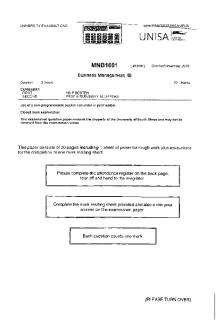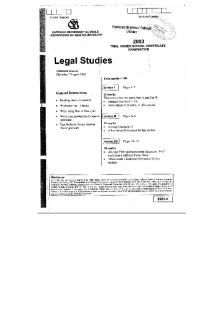ANS333 Past exam paper 2015 PDF

| Title | ANS333 Past exam paper 2015 |
|---|---|
| Course | Animal Production Systems III |
| Institution | Murdoch University |
| Pages | 10 |
| File Size | 259.8 KB |
| File Type | |
| Total Downloads | 38 |
| Total Views | 149 |
Summary
exam paper...
Description
Examinations Semester 1, 2015
UNIVERSIT Y
EXAM PAPER TO BE COLLECTED AND RETURNED TO EXAM!S OFFICE AT-T(R (XAM
Unit ANS353 Animal Production Systems EII Exam Type : Theory Reading time : 10 minutes (No note taking allowed) Exam Duration : 2 hours
INSTRUCTIONS All questions must be answered on the question paper directly. Marks allocated to each question are indicated on paper - allow 1 minute per mark. There are five sections in this exam: (I) Sheep and Wool industry (60 marks); (ii) Dairy industry (23 marks); (iii) Welfare and live export (15 marks); (iv) Control of feed intake (12 marks); and (v) Neat Technology (10 marks). This exam is worth 40% of your final mark for ANS353.
Given Name:
Family Name: Student No:
Signature:
EXAMINATION AIDS ALLOWED CLOSED BOOK EXAM Provided by the University NIL
groviged by the Candidate NXL
SECTION I Sheep and Wool Industry & Realth This section contains 22 questions worth a total of 60 marla.
"or this section - 60 minutes Question 1, The sheep and wool industry in Western Australia has changed dramatically since 1990. List four characteristics of these industries that have changed and the direction in which they have changed over' the last two decades, plus outline what factors have been responsible for each of these changes (3 marks).
Question 2. What is farm benchmarking and how can it be used by sheep producers to improve whole farm performance (2 marks)’/
Question 3. What are the two most important key profit drivers of lamb production systems and briefly explain how and why they influence profitability (2 mar1‹s)?
Question 4. Sheep producers generally run sub-optimal stocking rates because they worry about the cost and stress of carrying too many sheep in poor seasons which occur from time to time. List four strategies that they can adopt to reduce risks and enable them to cope better with these occasional poor seasons (2 marks)?
Question S. What is the main benefit of lambing self-replacing Merino flocks in late winter/early spring compared to autumn and what is a major challenge associated with late lambing (2 marks)?
Question 6. Work culling is one strategy to improve labour efficiency. Provide two examples of work culling and describe how these examples improve labour efficiency (2 marks)?
Question 7. List four characteristics of good sheep managers (2 marks)?
Question 8. List four animal factors which influence energy requirements and do they increase or decrease energy requirements (2 marks)?
3
Question 9. Describe the two main effects of improving nutrition on characteristics of the wool follicle and how these characteristics of the wool follicle influence the amount and characteristic of the wool produced (2 marks)?
Question 10. Describe when and how poor ewe nutrition during pregnancy can influence the development of wool follicles in the fetus and how this impacts on characteristics of wool produced by the progeny during their lifetime (4 marl‹s)?
Question 11. What is the main factor that influences wool growth rate for an individual sheep and describe how it influences the rate of wool growth (2 marks)?
4
Question 12. Describe how two fibre or staple characteristics can influence staple strength and describe two strategies that a farmer could adopt to improve the staple strength of wool produced by his/her weaners (4 marks)
Question 13. Wool and non-wool contaminants can reduce the price received for wool. List two management options to reduce vegetable matter contamination in fleece wool (2 marks) and two management options to reduce urine stained fibres in fleece wool (2 marks)
Question 14. What is an Australian Sheep Breeding Value and why is it better to select rams using their ASBYS rather than measures of their actual production (2
5
Question 15. The table below shows the ASBVs for a single ram and the average (avg.) for all rams in the sale. What is the predicted advantage in live weight and clean fleece weight at yearling age for progeny from this ram compared to the average ram in the sale (2 marks)
;\yt ASBV
1 4.1
-1.8
6.7
-0.5
2.9
0.6
Question 16. List four strategies to control flystrike and describe how they reduce the risk of flystrike (4 marks)?
6
Question 17. How would you go about eradicating a lice infestation and what strategies would you employ to ensure the sheep remain lice free? (3 marks)
Question 18. Resistance to chemicals is a major issue for internal and external parasites in sheep. How does resistance to chemicals develop and what are two management options to reduce to incidence of resistance (4 marks)
Question 19. List four strategies to increase reproductive rate of Merino ewe floc1‹s (2 mar1‹s)?
7
Question 20. Describe the ‘ram effect’ and how and when it can be used to manipulate sheep reproduction (2 marl‹s)
Question 21. About 30% of new born lambs die within 2 to 3 days of birth. Describe four management options to improve lamb survival including why they are likely to improve lamb survival (4 marks)
Question 22. More than 5% of weaners die in the 3-6 months following weaning. What are the two main risk factors for weaner mortality AND what are two main strategies that help to minimise the risk? (4 marl‹s)
END OF SECTION I...
Similar Free PDFs

ANS333 Past exam paper 2015
- 10 Pages

KIT710-2015 - past exam paper
- 6 Pages

AC506 Past Exam 2015
- 11 Pages

Exam 2015, questions - Past exam
- 7 Pages

STAT270 - past exam paper
- 24 Pages

Past exam Paper 2018
- 23 Pages

Trial past exam paper
- 7 Pages

MA103 Past Paper Exam
- 5 Pages

2010 exam - past paper
- 25 Pages

Past Exam Paper 2017-2018
- 2 Pages

2016 s2 - past exam paper
- 16 Pages

SBL Past Exam Paper 2019
- 20 Pages

Criminal Law Past Exam Paper
- 16 Pages

ECO1005 exam 2018-9 - Past Paper
- 3 Pages

all india bar exam past paper
- 10 Pages

AQA 71321 QP JUN17 - Past Exam Paper
- 24 Pages
Popular Institutions
- Tinajero National High School - Annex
- Politeknik Caltex Riau
- Yokohama City University
- SGT University
- University of Al-Qadisiyah
- Divine Word College of Vigan
- Techniek College Rotterdam
- Universidade de Santiago
- Universiti Teknologi MARA Cawangan Johor Kampus Pasir Gudang
- Poltekkes Kemenkes Yogyakarta
- Baguio City National High School
- Colegio san marcos
- preparatoria uno
- Centro de Bachillerato Tecnológico Industrial y de Servicios No. 107
- Dalian Maritime University
- Quang Trung Secondary School
- Colegio Tecnológico en Informática
- Corporación Regional de Educación Superior
- Grupo CEDVA
- Dar Al Uloom University
- Centro de Estudios Preuniversitarios de la Universidad Nacional de Ingeniería
- 上智大学
- Aakash International School, Nuna Majara
- San Felipe Neri Catholic School
- Kang Chiao International School - New Taipei City
- Misamis Occidental National High School
- Institución Educativa Escuela Normal Juan Ladrilleros
- Kolehiyo ng Pantukan
- Batanes State College
- Instituto Continental
- Sekolah Menengah Kejuruan Kesehatan Kaltara (Tarakan)
- Colegio de La Inmaculada Concepcion - Cebu